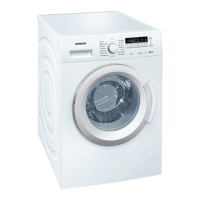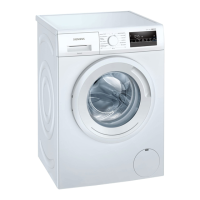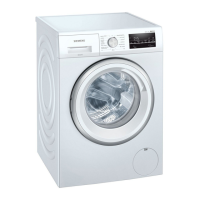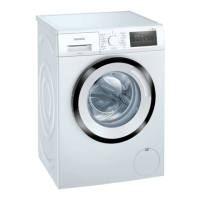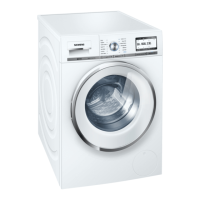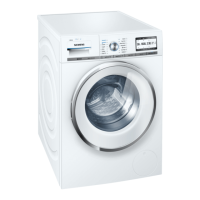7
Overview of programmes a Refer to the table of consumption values on page 8 and notes on page 6.
Programmes °C max.
Type of laundry
Additional functions; information
Bomuld (Cottons) 20, 30, 40, 60, 90 °C
6 kg/
3,5kg*
Hard-wearing fabrics, heat-resistant fabrics made
of cotton or linen
i (speed Perfect)*, h (Extra Rinse)
Hygiejne
(Sensitiv)
60°C
Bomuld
(Cottons) eco
40, 60 °C 6 kg i (speed Perfect)*, h (Extra Rinse)
Strygelet
(Easy-Care)
30, 40 °C 3 kg
Easy-care fabrics made of cotton, linen, synthetic
fibres or blended fabrics
i (speed Perfect), h (Extra Rinse)
Mix 40 °C 2.5 kg Fabrics made of cotton or easy-care fabrics
i (speed Perfect), h (Extra Rinse); different types of laundry
can be washed together
Finvask/Silke
(Delicate/Silk)
30 °C
2 kg
For delicate, washable fabrics, e.g. made of silk,
satin, synthetic fibres or blended fabrics (e.g. cur-
tains)
i (speed Perfect), h (Extra Rinse)
No spin between rinse cycles
ÿ Uld/Håndvask
(Wool/hand wash)
30 °C
Handä or machine-washable fabrics made of wool
or containing wool
Particularly gentle wash programme to prevent shrinkage of
laundry. Longer programme breaks (fabrics rest in the detergent
solution)
Additional programmes Skyl (Rinse), Centrifugering (Spin)/Udpumpning (Empty)
* reduced load
when using the i (speed Perfect) option.
Programmes without prewash - add detergent to compartment II, programmes with prewash - distribute the detergent between compartments I and II.
9511 / 9001069597
WM12B166DN
BSH Hausgeräte GmbH
Carl-Wery-Straße 34 81739 München GERMANY
Manufactured by BSH Hausgeräte GmbH under Trademark License of Siemens AG
8
Safety instructions
– Read the instruction manual and installation instructions and all other information enclosed
with the washing machine and act accordingly.
– Retain the documents for subsequent use.
Risk of electric shock – Never pull the cable to disconnect the mains plug.
– Never insert/disconnect the mains plug with damp hands.
Danger to life For worn-out appliances:
– Disconnect the mains plug.
– Sever the mains cable and discard along with the plug.
– Destroy the lock on the washing machine door. This will prevent
children from locking themselves in and risking their lives.
Danger of suffocation – Keep packaging, film and packaging parts out of the reach of
children.
Risk of poisoning – Keep detergents and care products out of the reach of children.
Risk of explosion – Items of laundry pretreated with cleaning agents containing
solvents, e.g. stain remover/cleaning solvent may cause an
explosion after being loaded into the washing machine.
Rinse items of laundry thoroughly by hand beforehand.
Risk of injury – The washing machine door can become very hot.
– Be careful when draining hot detergent solution.
– Do not climb onto the washing machine.
– Do not lean on the open washing machine door.
– Do not reach into the drum if it is still rotating.
– Be careful when opening the detergent drawer while the machine
is in operation.
Consumption values
Programme Load Electricity*** Water*** Programme duration***
Bomuld (Cottons) 20 °C 6 kg 0.30 kWh 68 l 2 @ h
Bomuld (Cottons) 30 °C 6 kg 0.95 kWh 68 l 2 @ h
Bomuld (Cottons) 40 °C* 6 kg 1.60 kWh 68 l 2 @ h
Bomuld (Cottons) 60 °C 6 kg 2.45 kWh 76 l 2 @ h
Bomuld (Cottons) 90 °C 3 kg 0.70 kWh 46 l 1 B h
Strygelet (Easy-Care) 40 °C* 2,5 kg 0.40 kWh 44 l 1 h
Finvask/Silke (Delicate/Silk) 30 °C 2 kg 0.30 kWh 37 l B h
ÿ Uld /Håndvask (Wool) 30 °C 2 kg 0.20 kWh 43 l B h
*Programme setting for testing in accordance with currently applicable EN60456 standard.
Note on comparative tests: When testing the test programmes, wash the specified load using the
maximum spin speed.
Programme Load Annual energy consumption Annual water consumption
Bomuld (Cottons) eco 40 / 60 °C ** 6/3 kg 153 kWh 10560 l
** Programme settings for testing and energy labelling in accordance with europian standard
2010/30/EU with cold water(15 °C).
***The values may deviate from the specified values depending on water pressure, water hard-
ness, and inlet temperature, ambient temperature, type, amount and level of laundry soiling,
detergent used, fluctuations in the power supply and selection of options.
8

